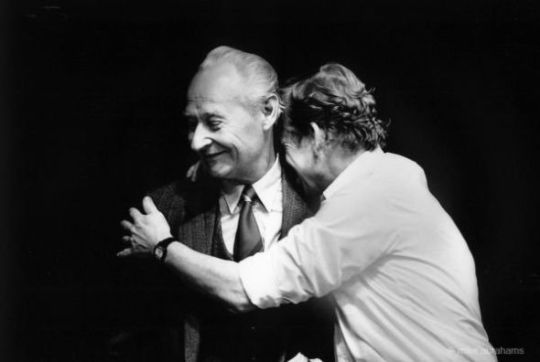#Alexander Dubček
Text
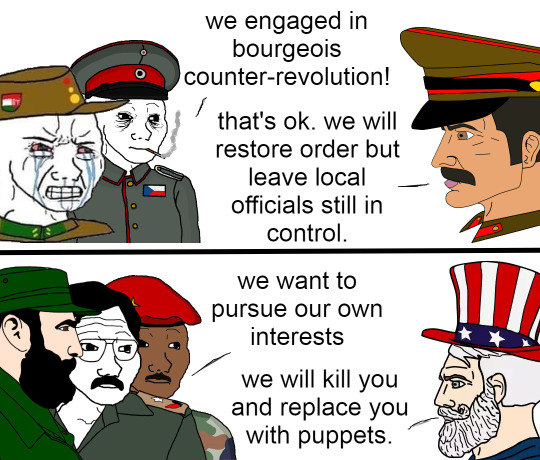
The Soviet intervention in Hungary in 1956 and Czechoslovakia in 1968 were objectively far better than what the US tends to do when countries anywhere defy its hegemony.
#socialism#communism#marxism#politics#united states#soviet union#history#prague spring#Hungarian Uprising#Hungary#Czechoslovakia#Warsaw pact#imre Nagy#Alexander Dubček
171 notes
·
View notes
Video
youtube
LECTURE 18: COMING APART (PART 1): Have a look at this fascinating documentary about Prague Spring 1968, that moment in the history of Czechoslovakia when moderate communist reformers came to power and tried to implement a less repressive form of “Socialism With a Human Face.” As this documentary segment points out, the leader of Prague Spring, Alexander Dubček, was a loyal Communist Party who simply wanted to see genuine reform occur in his country. Unfortunately, the communist leadership in the Soviet Union did not share his fervent wish for reform, and Soviet tanks soon rolled into Prague to crush the idealistic rebellion. In this documentary from the series titled COLD WAR, narrated by Kenneth Branaugh, offers a balanced view of the tragic and brutal response to Prague Spring. At about 39:50 in this film, the grim Soviet invasion begins.
#1968#Prague Spring#Czechoslovakia#Alexander Dubček#Soviet Union#Cold War#documentaries#invasion#Kenneth Branaugh
0 notes
Photo

Soviet tanks roll into Prague, 1968. (Photograph: Josef Koudelka/Magnum Photos)
The Prague spring began on 5 January 1968, when Alexander Dubček took over the Czechoslovakian Communist party from his Stalinist predecessor; he introduced reforms that distanced his party from Moscow and promised “socialism with a human face”. Seven months later, Soviet tanks invaded and Dubček was eventually deposed. Josef Koudelka took about 5,000 photographs that week documenting acts of resistance by civilians but his identity was kept anonymous to prevent reprisals. After smuggling his film abroad, Koudelka fled the country, revealing himself to be the “Prague Photographer” only following the death of his father in 1984. GS
3 notes
·
View notes
Text
Events 4.17 (after 1950)
1951 – The Peak District becomes the United Kingdom's first National Park.
1961 – Bay of Pigs Invasion: A group of Cuban exiles financed and trained by the CIA lands at the Bay of Pigs in Cuba with the aim of ousting Fidel Castro.
1969 – Sirhan Sirhan is convicted of assassinating Robert F. Kennedy.
1969 – Communist Party of Czechoslovakia chairman Alexander Dubček is deposed.
1970 – Apollo program: The damaged Apollo 13 spacecraft returns to Earth safely.
1971 – The Provisional Government of Bangladesh is formed.
1975 – The Cambodian Civil War ends. The Khmer Rouge captures the capital Phnom Penh and Cambodian government forces surrender.
1978 – Mir Akbar Khyber is assassinated, provoking the Saur Revolution in Afghanistan.
1982 – Constitution Act, 1982 Patriation of the Canadian constitution in Ottawa by Proclamation of Elizabeth II, Queen of Canada.
1986 – An alleged state of war lasting 335 years between the Netherlands and the Isles of Scilly declared peace bringing an end to any hypothetical war that may have been legally considered to exist.
1992 – The Katina P is deliberately run aground off Maputo, Mozambique, and 60,000 tons of crude oil spill into the ocean.
2003 – Anneli Jäätteenmäki takes office as the first female prime minister of Finland.
2006 – A Palestinian suicide bomber detonates an explosive device in a Tel Aviv restaurant, killing 11 people and injuring 70.
2013 – An explosion at a fertilizer plant in the city of West, Texas, kills 15 people and injures 160 others.
2014 – NASA's Kepler space telescope confirms the discovery of the first Earth-size planet in the habitable zone of another star.
2021 – The funeral of Prince Philip, Duke of Edinburgh, takes place at St George's Chapel, Windsor Castle.
0 notes
Text
Muž, který stál v cestě | CELÝ FILM [2023] 𝐎𝐍𝐋𝐈𝐍𝐄 ZDARMA CZ/SK DABING I TITULKY
Před 7 minutami — Sleduj Muž, který stál v cestě (2023) Film Online Zdarma CZ Dabingom i Titulky celý film online česko-slovenská. Raj všetkých online filmov a seriálov 2023 úplne zadarmo a navyše bez otravných reklám..
Muž, který stál v cestě online film (2023) - Muž, který stál v cestě - Muž, který stál v cestě. 2023 - Sleduj Muž, který stál v cestě (2023) – Celý Film CZ Dabing HD Kvalite | Sleduj Filmy Online, Muž, který stál v cestě (2023) – Online Titulky Filmu Dabing CZ, Muž, který stál v cestě (2023) – Sleduj Filmy Online CZ Dabing HD Kvalite, [Bombuj-HD] Muž, který stál v cestě (2023) Film CZ Dabing [Online], [Sledovat-HD] Muž, který stál v cestě (2023) Film Online [CZ Dabing]
Muž, který stál v cestě (2023) — Film Online Sledujte Muž, který stál v cestě (2023) filmy online. Můžete sledovat Muž, který stál v cestě film online v HD Quality!
: ► Klikněte zde pro shlédnutí filmu Muž, který stál v cestě- Online zdarma v HD
| DVD (Blu-ray) | 4K UHD | HD-2080p | HD-720p | SD-480p | MP4 |
Sledovat online : Muž, který stál v cestě (2023)
Stažení : Muž, který stál v cestě (2023)

Další název: Muž, který stál v cestě
Žánr: Drama, Historický,
Země: Spojené státy americké
Premiéra v ČR: 2023-05-25
Délka: 120 min.
hraje:
Tomáš Töpfer, Zuzana Mauréry, Adrian Jastraban, Oleksandr Ihnatusha, Alois Švehlík, Jiří Ployhar, Daniel Heriban, Přemysl Bureš, Jaroslav Mendel, Zuzana Kajnarová, Miroslav Táborský, Lukáš Kantor, Antonín Kala, Gustav Řezníček, Jan Fiala, Oleksandr Klauning,
Obsah filmu Muž, který stál v cestě:
Strhující příběh lékaře a politika Františka Kriegla zachycuje dramatické události 21. srpna 1968, kdy byl v noci společně s čelními představiteli KSČ (Alexander Dubček, Oldřich Černík, Josef Smrkovský, Josef Špaček, Bohumil Šimon) zatčen a unesen do Moskvy. Byl jediným československým politikem, který se v zajetí i pod hrozbou likvidace postavil Leonidu Iljiči Brežněvovi a nepodepsal Moskevský protokol, dokument, jenž znamenal souhlas s okupací Československa.
Kroky ke stažení filmů
* Můžete navštívit webové stránky prostřednictvím odkazů, které jsme poskytli následovně: povodeň
* Navštivte stránky, které již doporučujeme a vyhledejte film, který chcete sledovat a stahovat. Pro zjednodušení můžete použít funkci vyhledávání.
* Po nalezení filmu, který se vám líbí, klikněte na kartu Hry. Pokračujte v stahování hrozby „Muž, který stál v cestě“ a stáhněte film do požadované kvality. Viz obrázek, aby bylo jasnější.
Klíčová slova
Muž, který stál v cestě celý film zdarma ke shlédnutí,
Muž, který stál v cestě cz dabing online ke shlednuti,
Muž, který stál v cestě Filmy Česky a Zdarma,
Muž, který stál v cestě online ke shlednuti,
Muž, který stál v cestě Informace o filmu,
Muž, který stál v cestě online cely film,
Muž, který stál v cestě Sleduju Online,
Muž, který stál v cestě online bombuj,
Muž, který stál v cestě online,
Muž, který stál v cestě online film cz,
Muž, který stál v cestě Bombuj,
Muž, který stál v cestě bombuj cz,
0 notes
Text
0 notes
Text
His Dad packed hashish into his favorite pipe. “Well, son, it’s like this. Back when I was your age, in 1989, I pulled on my backpack, and I hitch-hiked to Prague. No money, and no passport, with Communist troops and cops all over the place. For sure, I got into some jams. But I wouldn’t have missed that for anything! That was the only Revolution that us hippies ever won.”
The Velvet Revolution (Czech: Sametová revoluce) or Gentle Revolution (Slovak: Nežná revolúcia) was a non-violent transition of power in what was then Czechoslovakia, occurring from 17 November to 28 November 1989. Popular demonstrations against the one-party government of the Communist Party of Czechoslovakia included students and older dissidents. The result was the end of 41 years of one-party rule in Czechoslovakia, and the subsequent dismantling of the command economy and conversion to a parliamentary republic.[2]
On 17 November 1989 (International Students' Day), riot police suppressed a student demonstration in Prague.[3] The event marked the 50th anniversary of a violently suppressed demonstration against the Nazi storming of Prague University in 1939 where 1,200 students were arrested and 9 killed (see Origin of International Students' Day). The 1989 event sparked a series of demonstrations from 17 November to late December and turned into an anti-communist demonstration. On 20 November, the number of protesters assembled in Prague grew from 200,000 the previous day to an estimated 500,000. The entire top leadership of the Communist Party, including General Secretary Miloš Jakeš, resigned on 24 November. On 27 November, a two-hour general strike involving all citizens of Czechoslovakia was held.
In response to the collapse of other Warsaw Pact governments and the increasing street protests, the Communist Party of Czechoslovakia announced on 28 November that it would relinquish power and end the one-party state. Two days later, the federal parliament formally deleted the sections of the Constitution giving the Communist Party a monopoly of power. Barbed wire and other obstructions were removed from the border with West Germany and Austria in early December. On 10 December, President Gustáv Husák appointed the first largely non-communist government in Czechoslovakia since 1948, and resigned. Alexander Dubček was elected speaker of the federal parliament on 28 December and Václav Havel the President of Czechoslovakia on 29 December 1989.
In June 1990, Czechoslovakia held its first democratic elections[4] since 1946. On 1 January 1993, Czechoslovakia peacefully split into two countries, the Czech Republic and the Slovak Republic.
The dissolution of Czechoslovakia occurred mainly due to national governance issues between the Slovaks and Czechs (the two major ethnicities comprising the former Czechoslovakia).
#Czech Republic#Slovak republic#1989#Velvet#Revolution#Student#Demonstrations#Václav Havel#general strike#author#poet#playwright#Dissident
1 note
·
View note
Text
Political oppression and resistance in Jiří Trnka’s Ruka/The Hand (1965)
In 1965, the Czech draughtsman, book illustrator, puppet and toy designer, painter, animated film-maker and sculptor Jiří Trnka released his last short animation film Ruka/The Hand (1965). The silent 18 minute animation delivers a powerful and chilling dynamic; allegorically and metaphorically representing the influence of the communist political regime on the freedom of people through the framing of Trnka as the main character (a harlequin) and the accompanying image of the hand, which overpowers harlequin’s agency). Whilst remaining a communist state, Czechoslovakia experienced a short period or freedom under Alexander Dubček leadership during which the opposition against political repression was communicated through the arts. Trnka used animation to both record his reality and condemn it. Nonetheless, Ruka was meant to deliver a critique of Stalin and for this reason, it was banned in the Czech Republic until the end of communism. symbolic valence of the short and how Trnka’s stop motion animation style portrays the themes of oppression and resistance.
https://www.fantasy-animation.org/current-posts/political-oppression-and-resistance-in-ji-trnkas-ruka-the-hand-1965
0 notes
Video
youtube
LECTURE 18: COMING APART (PART 1): Have a look at this fascinating documentary about Prague Spring 1968, that moment in the history of Czechoslovakia when moderate communist reformers came to power and tried to implement a less repressive form of “Socialism With a Human Face.” As this documentary segment points out, the leader of Prague Spring, Alexander Dubček, was a loyal Communist Party who simply wanted to see genuine reform occur in his country. Unfortunately, the communist leadership in the Soviet Union did not share his fervent wish for reform, and Soviet tanks soon rolled into Prague to crush the idealistic rebellion. In this documentary from the series titled COLD WAR, narrated by Kenneth Branaugh, offers a balanced view of the tragic and brutal response to Prague Spring. At about 39:50 in this film, the grim Soviet invasion begins.
#1968#Prague Spring#Czechoslovakia#Soviet Union#Alexander Dubček#Cold War#documentaries#Kenneth Branaugh#invasion
2 notes
·
View notes
Video
youtube
Crash Course European History #45: Protests East and West
#crash course#european history#crash course european history#protests#protest#john green#hank green#stan muller#bonnie smith#meredith danko#doug fellegy#jan palach#václav havel#aleksandr solzhenitsyn#charles de gaulle#alexander dubček#simone de beauvoir#1968#may 68
12 notes
·
View notes
Video
youtube
LECTURE 18: COMING APART (PART 1): Have a look at this fascinating documentary about Prague Spring 1968, that moment in the history of Czechoslovakia when moderate communist reformers came to power and tried to implement a less repressive form of “Socialism With a Human Face.” As this documentary segment points out, the leader of Prague Spring, Alexander Dubček, was a loyal Communist Party who simply wanted to see genuine reform occur in his country. Unfortunately, the communist leadership in the Soviet Union did not share his fervent wish for reform, and Soviet tanks soon rolled into Prague to crush the idealistic rebellion. In this documentary from the series titled COLD WAR, narrated by Kenneth Branaugh, offers a balanced view of the tragic and brutal response to Prague Spring. At about 4:45 in this film, the grim Soviet invasion begins.
1 note
·
View note
Text
January 5
In 1968, reformist Alexander Dubček was elected First Secretary of the Communist Party of Czechoslovakia, thus kicking off what came to be known as the Prague Spring. That all came to an end in August of the same year, when Soviet forces invaded the country and deposed the First Secretary. Originally, historians insisted that Dubček's reforms had angered the more conservative Soviet leader Leonid Brezhnev, but recent documents have come to light that paint a different picture.
It turns out that the Czech language has vowel and consonant sounds the Russians don't have. So Brezhnev THOUGHT that a country in his sphere of influence was being led by a man named "Alexander Dubstep," and, obviously, he couldn't live with that. So he sent in the troops.
And if you don't know, now you know.
#history#Warsaw Pact#Czechoslovakia#Prague Spring#Soviet Union#USSR#Leonid Brezhnev#Alexander Dubček#Some of this is just not true in any way#I trust you can figure out which part#Still better than that time the Soviets invaded Hungary over Skrillex
7 notes
·
View notes
Text
Events 1.5 (after 1950)
1953 – The play Waiting for Godot by Samuel Beckett receives its première in Paris.
1957 – In a speech given to the United States Congress, United States President Dwight D. Eisenhower announces the establishment of what will later be called the Eisenhower Doctrine.
1967 – Cultural Revolution: The Shanghai People's Commune is established following the seizure of power from local city officials by revolutionaries.
1968 – Alexander Dubček comes to power in Czechoslovakia, effectively beginning the "Prague Spring".
1969 – The Venera 5 space probe is launched at 06:28:08 UTC[24] from Baikonur.
1969 – Ariana Afghan Airlines Flight 701 crashes in Fernhill, West Sussex, while on approach to Gatwick Airport, killing 50 people.
1970 – The 7.1 Mw Tonghai earthquake shakes Tonghai County, Yunnan province, China, with a maximum Mercalli intensity of X (Extreme). Between 10,000 and 15,000 people are known to have been killed and about another 26,000 are injured.
1972 – US President Richard Nixon announces the Space Shuttle program.
1975 – The Tasman Bridge in Tasmania, Australia, is struck by the bulk ore carrier Lake Illawarra, killing twelve people.
1976 – The Khmer Rouge announce that the new Constitution of Democratic Kampuchea is ratified.
1976 – The Troubles: Gunmen shoot dead ten Protestant civilians after stopping their minibus at Kingsmill in County Armagh, Northern Ireland, UK, allegedly as retaliation for a string of attacks on Catholic civilians in the area by Loyalists, particularly the killing of six Catholics the night before.
1991 – Georgian forces enter Tskhinvali, the capital of South Ossetia, Georgia, opening the 1991–92 South Ossetia War.
1991 – Somali Civil War: The United States Embassy to Somalia in Mogadishu is evacuated by helicopter airlift days after the outbreak of violence in Mogadishu.
1993 – The oil tanker MV Braer runs aground on the coast of the Shetland Islands, spilling 84,700 tons of crude oil.
2005 – The dwarf planet Eris is discovered by Palomar Observatory-based astronomers, later motivating the International Astronomical Union (IAU) to define the term planet for the first time.
2014 – A launch of the communication satellite GSAT-14 aboard the GSLV MK.II D5 marks the first successful flight of an Indian cryogenic engine.
2022 – Kazakh President Kassym-Jomart Tokayev dismisses Prime Minister Asqar Mamin and declares state of emergency over the 2022 Kazakh unrest.
0 notes
Photo
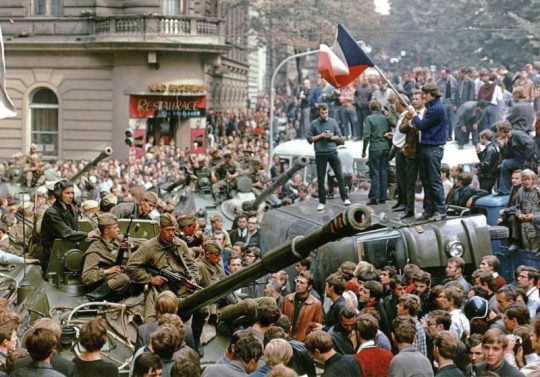
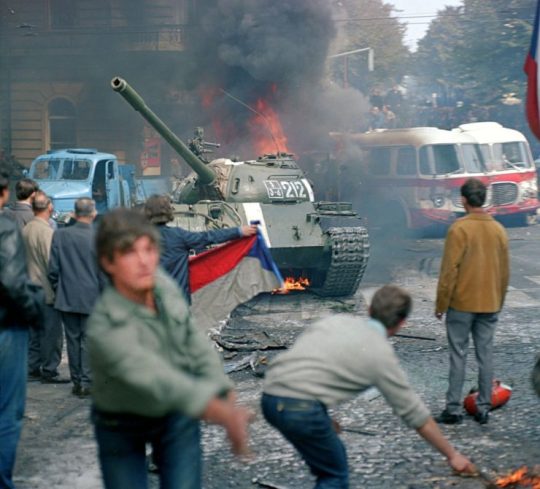
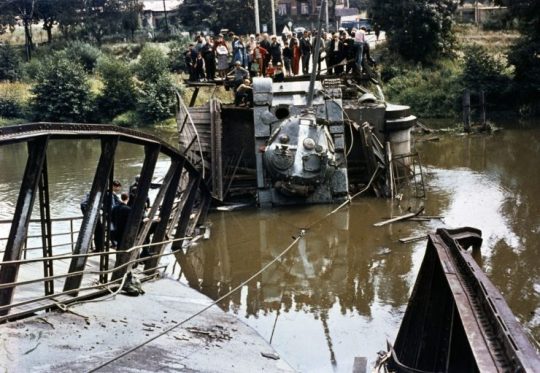
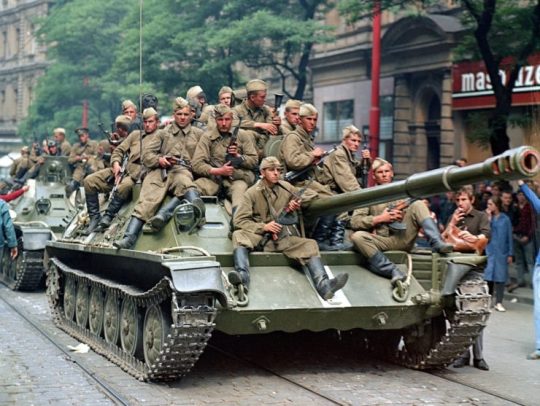

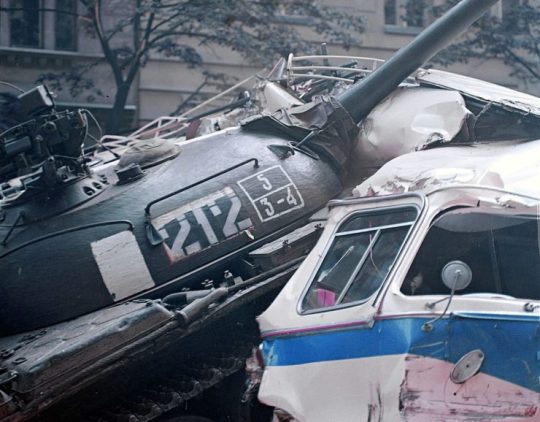
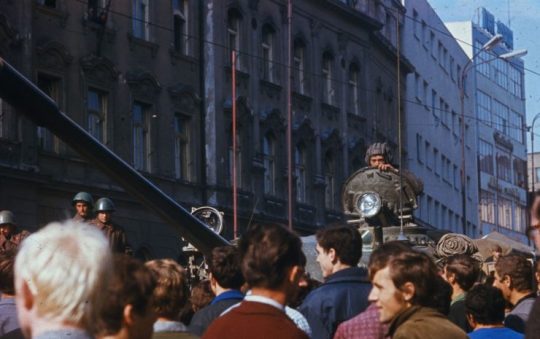
In 1968, during a period called the “Prague Spring,” Alexander Dubček, the newly elected leader of Czechoslovakia, enacted pro-democracy reforms that loosened state control and expanded individual rights, giving hope to citizens and angering the Soviet Union.
Soviet leaders in Moscow believed that Czechoslovakia, a member of the Warsaw Pact, had gone too far, and summoned the country’s leaders for discussions. By late summer, the talks were not going the way the Kremlin had wanted, so more than 2,000 tanks and thousands more Warsaw Pact troops were sent to invade and occupy the country on August 21.
In the first weeks, occupying soldiers were met with protests and limited resistance, and more than 70 civilians were killed in the conflicts.
#prague spring#prague#history#soviet union#ussr#cold war#russia#Russian army#czech#Czech republic#Czech history
462 notes
·
View notes
Text
The Story Of The Abandoned Car Factory Pragovka
Prague is a city of postcard-perfect architecture: from immaculate works of Gothic beauty – like St. Vitus Cathedral and the 13th century Old New Synagogue in Josefov – to the statue-lined Charles Bridge, or the monumental neo-Renaissance building of the National Museum looking out across Wenceslas Square. It is not a city that most would associate with industrial decay, however Prague’s former palaces of industry are no less grand, even while history is in the process of burying them.

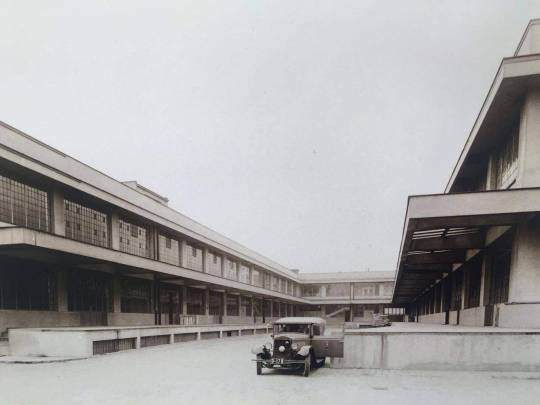
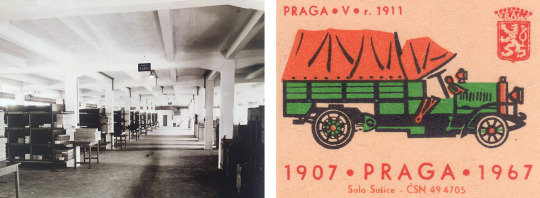
The Praga Car Factory Pragovka. | Photo via E-Factory.cz
The Praga Car Factory Pragovka on the city’s eastern edge was once the beating heart of the Czechoslovak manufacturing industry. It played a significant role in the city’s 20th century history, but it was here at the Prague’s darkest days was set into motion. In 1968 workers at Pragovka sent a letter to the Soviet Embassy requesting support in the fight against liberalisation. This letter, published in Pravda, would then be used as justification for the Warsaw Pact invasion of Czechoslovakia.

The Praga Car Factory today. | Photo Katka Havlíková
Pragovka is abandoned since the turn of the 21st century and is now a sprawling ruin, its extravagant factory halls succumbing slowly to time and nature. In 2017 I went to explore what was left of it. The Car Factory was founded in 1907 as a manufacturing site in the eastern suburbs of Prague, with just 30 employees. Two years later, its parent company adopted the name ‘Praga’ – the car brand used the Latin form of the city’s name in the hope of sounding more international. During WWI the Praga factory (then known as the First Czech-Moravian Machine Factory) supplied the Austro-Hungarian army; then after 1918 and the independence of Czechoslovakia, it began to focus more on passenger cars.

The main hall of the Pragovka factory in 2017. | Photo Katka Havlíková
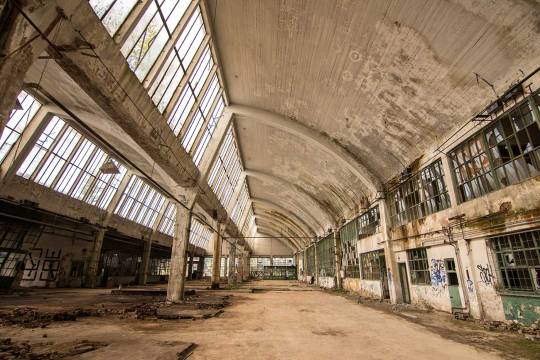
The large, angled windows allowed plenty of natural light to enter, reducing electricity costs. | Photo Katka Havlíková
In 1927 Praga was incorporated into the new ČKD (Českomoravská Kolben-Daněk) group, one of the largest engineering companies in Czechoslovakia. Among other vehicles (including tanks, locomotives, tractors, motorcycles and metro cars), ČKD produced cars under the Praga, Škoda and Tatra brands, and was famous for making the Tatra T3 tramcar – a design which would sell almost 14,000 units, and become an iconic sight on the streets of socialist cities from Sarajevo to Tashkent. Meanwhile as many as half of the taxis on Prague’s streets had rolled out of this factory.

Left: Cover of a 1962 sales brochure from Strojexport, featuring the Tatra T3 tramcar. Right: Vintage poster featuring the Tatra T77.
In recent years, the Pragovka complex has been recognised as a heritage site and some of its spaces have been developed into an arts district. There is a retro-themed ‘Pragovka Cafe,’ and the place hosts film screenings, concerts and festivals. Reportedly as many as a hundred local artists have studios now on the former factory grounds, while the large E-Factory building has been converted into a gallery space.

Some outer buildings still remain, linked by covered walkways. Other buildings have been bulldozed. | Photo Katka Havlíková
There’s talk of building apartments here too in future, a trendy new community rising up amidst the industrial decay. A large part of the complex remains off-limits for now though – and it was here that we entered. During the visit of Prague was fortunate enough to be offered a tour of its best ruins the local photographer Katka Havlíková.

Raised gas pipes above an overgrown courtyard. | Photo Katka Havlíková

The factory has been abandoned long enough for creepers and graffiti to cover many of its surfaces. | Photo Katka Havlíková

Katka picks a careful path through the debris-field, towards the first of the factory’s grand production halls. | Photo Katka Havlíková
She led us around the back of the factory where we scrambled up a slope of rubble to reach a promontory at the corner of the former yard. Ahead of us lay a sea of green. Thick vegetation hid the concrete courtyard, with only the occasional street light, rising like drowning hands from water, to suggest that anything unnatural lay beneath. The main buildings, those still standing, were just visible through the trees and so we cut a path down through the overgrown wreckage towards the old factory halls.
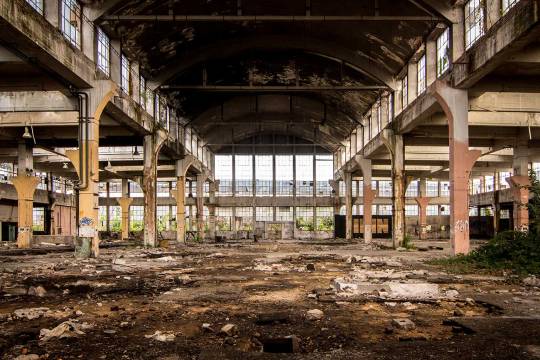
The largest of Pragovka’s manufacturing halls looks no less grand today with its full-height windows. | Photo Katka Havlíková
After poking around in a few of the outer buildings that rise now out of bushes and debris, we made it finally to the main manufacturing halls of Pragovka. It was strange to see a building this grand left to ruin. The complex was built back in a time when factories and power plants were temples of the people – places of pride, not merely function, their spaces defined with grand architectural flourishes. This main hall could have been a train station, not a car factory. Natural light illuminated the hall from floor-to-ceiling windows (much of their glass still intact), while pillars supported an arched ceiling high above.

Nature creeps into Pragovka – vines find a way inside through broken window, letterboxes, or any other breach in the outer wall. | Photo Katka Havlíková
We didn’t see the new arts district at all – a fact indicative of just how large this complex was – but it was hard to imagine how any small business or community project could successfully take over a space like this. The factory halls were beautiful, but built on such a scale that maintenance and repairs would be an extraordinary burden, particularly after all these years of decline.
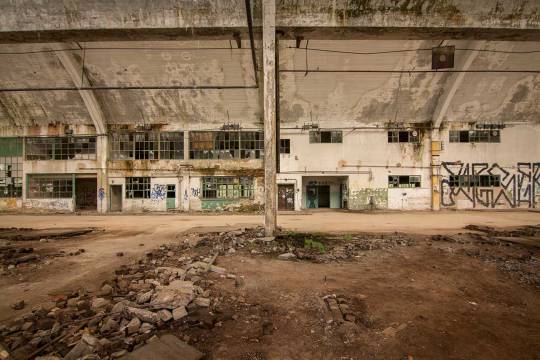
Two levels of offices lined the wall. | Photo Katka Havlíková

A staircase connects floors inside the main building. | Photo Katka Havlíková
The seeming inevitability of this factory’s ruin cast a melancholy mood over the few hours we spent wandering the halls of Pragovka. Right now, like this, with the warm sun slicing in sideways through the dirty glass windows, and the greenery of nature’s scouts – along with bursts of bright graffiti – lending fresh colour to the otherwise muted palette of pastel-painted walls and pillars: Pragovka might never look this good again.

Old ledgers amongst broken glass in the courtyard.| Photo Katka Havlíková
When Pragovka falls, much of its history will be buried with it; and perhaps for some, that might be for the best. Pragovka is remembered not only as the heart of the Czechoslovak manufacturing industry, but it is also a place where the communists made their stand – forever linking these buildings with a historic victory for the pro-Soviet movement. In 1968 the Soviet Union and its allies led an overnight invasion of Czechoslovakia – to suppress the Prague Spring, a growing liberalisation movement under First Secretary Alexander Dubček. Although history remembers the event as an act of totalitarian foreign aggression, that invasion was not, in fact, universally unwelcome.

A wall has collapsed to reveal the stairwell inside. | Photo Katka Havlíková
Numerous workers’ unions in Czechoslovakia supported Soviet intervention in their country, and one of the key triggers of the invasion was a letter of invitation, that was written here, at the Praga Car Factory. In 1971 the Czechoslovak journalist Josef Maxa authored A Year is Eight Months, which recounts the events of the Prague Spring and leading up to the invasion. “Moscow’s Pravda published a letter from ninety-nine workers in the Pragovka factory in Prague to the Soviet Embassy,” he wrote. “The letter denounced the Czechoslovakian enemies of socialism and of the Soviet Union.” That document was known as the “Letter of the Ninety-nine Praguers,” and it warned the Soviet Embassy how: “the manifestations of the democratisation of society in our republic threaten the building of socialism and in so doing, attack the blood-hardened friendship between the Czech and Soviet peoples” (as paraphrased by Martin Půlpán).
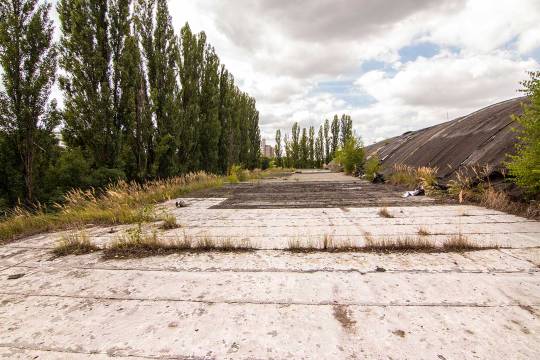
Rooftop above one of the manufacturing halls.| Photo Katka Havlíková
The letter claimed that all honest citizens of Czechoslovakia felt safer in the presence of Soviet and Warsaw Pact troops occupying their country. When Pravda printed the letter, on 30 July 1968, along with all ninety-nine signatures, the document would be used as justification for the swift invasion that followed in August. The incoming normalisation government that subsequently took charge of Czechoslovakia would valorise the authors of that letter – raising a memorial plaque at the main entrance to Pragovka, that read: “In the revolutionary tradition of this great workers’ nation, a letter with ninety-nine signatures was sent to the USSR in the critical year of 1968, requesting support and assistance in fighting anti-socialist forces.”

A bright and airy side room near the main factory floor. | Photo Katka Havlíková
Nowadays that plaque is long gone. The gates of Pragovka stand barred, and the halls where the letter was written are lost to a maze of rubble, weeds and graffiti. The factory’s decline today is an inevitability – it is a temple to a lost industry, a relic displaced from its time and no longer fit for purpose in the new industrial landscape of the Czech Republic.
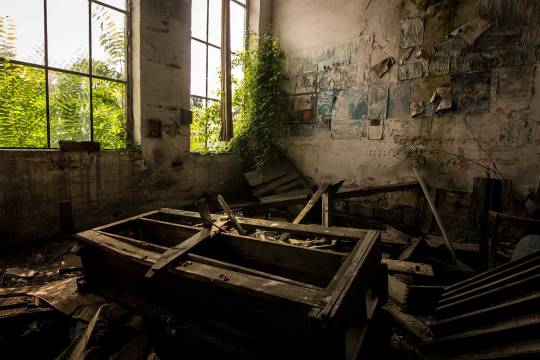
The wall in a former office space. | Photo Katka Havlíková
Though Pragovka’s political history likely doesn’t help to endear these halls to the citizens of contemporary Prague – and it’s hard not to read some level of symbolism as this celebrated factory, once enshrined like a victorious battlefield in Czechoslovakia’s communist historiography, is slowly carved up, and crushed, by the oncoming future.
--
by Darmon Richter
[adapted with permission from an article at Ex Utopia]
21 notes
·
View notes
